The garment industry, be it first-hand garments or used apparel, is a need-based industry which is why it has always grown and never decreased in terms of revenue. Among the leading garment manufacturers of the world, Turkey also has its place. One reason why Turkey is an important garment manufacturer and exporter of the world is that it has introduced unique forms of clothing and fashion to the world. The cultural clothing of Turkey as well as growth in the modeling of Turkey’s cultural clothing has resulted in a sharp rise in the demand for apparel in Turkey as well as abroad.
Overview of the Garment Industry of Turkey
Revenues in the garment industry of Turkey have reached $14.48 billion by 2022 with a forecasted growth rate of the market at 5.96% CAGR between 2022 and 2026. While the volume of garment products in Turkey is quite high at about 4.6 billion pieces (forecast for 2026), the main reason for low revenue in terms of the dollar is because of the significant fall in the value of the Turkish currency against the United States dollar due to different political issues. The most important segment of the garment industry in Turkey is the women’s apparel market which generated almost 50% of the sales at about $7.6 billion in 2022.
In addition to that, statistics show that the average volume per person in the Apparel market is 49.6 pieces while the per person revenue generated is $169.2. Due to the fall in the value of the Turkish currency, there has been an increase in the demand for commonly produced goods and not the demand for luxury goods. As a result of this, statistics show that 99% of the garment sales in Turkey are from the sales of non-luxury goods.
E-Commerce Market of Garments in Turkey
Out of the total market size mentioned above, the online marketplace has significant sales too. The e-commerce garment industry of Turkey has made $2.85 billion in revenue in 2022. While this may not seem much compared to other countries, a shocking aspect of the garment industry of Turkey is the growth rate which is at 31.8% and projected to reach market revenue of $6.54 by 2025. Statistically, this means that Turkey is just 3.2 years away from a 100% growth in the online marketplace for garments compared to the current position. It also indicates how strongly the demand for online shopping of Turkish clothes is increasing as well as how Turkey is likely to benefit in terms of better Gross Domestic Product.
User penetration in the online markets for the garment industry of Turkey is 26.8% currently and is forecasted to cross 34% by 2025. Despite the falling value of the Turkish Lira and various economic problems faced by Turkey, there has been a consistent rise in the average revenue generated per person. As of 2022, the average revenue per user for online purchase of garments in Turkey is around $124.4 which is quite high with regards to its economic position.
Garment Industry of Turkey | Detailed Analysis
The garment industry of Turkey is huge and is supported by 20 thousand firms engaged in the production of textiles from raw cotton while 53 thousand firms produce garments from cotton. The huge production of ready-made garments in Turkey is not only used for fulfilling the local demand but is also used to pursue the exports of a country. One report also suggests that Turkey is the 5th largest producer of textile and garment products. In addition to that, the garment industry accounts for 10% of the GDP of the country while 20% of the country’s workforce is also engaged in the same sector.
One reason why Turkey is preferred over many other countries for the production of garments is that it has easy access to high-quality materials for the production of garments in the country. In comparison with China, India, Vietnam, Bangladesh, and Pakistan, Turkey enjoys a special competitive advantage in terms of high-quality production of garments.
Another benefit that the garment industry of Turkey enjoys is the special privileges from the government of Turkey. There are no major hurdles, taxes, or any other forms of strict regulations for the producers. Instead, the producers are given incentives to make sure that they produce over and above as it helps the country prosper with increased Gross Domestic Product.
The fashion sense in Turkey is not that diverse and there is even restriction on some forms of clothing. As the country is an Islamic country, it prohibits women to wear clothing that shows parts of their body beneath their face and above their feet. Similarly, men are also prohibited from wearing shorts, tank tops, or sleeveless clothing. The main reason is to ensure that the clothing is not “too revealing”. However, even if someone wears it, there isn’t much of an issue. Nonetheless, generally, it is a part of their culture to follow the concept of not revealing much which is why the garments produced for the local market are in accordance with this principle.
As a result, casual clothing in Turkey includes wearing T-shirts, skirts, covered tops, and shalwars . While women can wear western clothing, they are generally seen with more respect if they follow the culture. Women can also wear full dresses, jumpsuits, and other forms of clothing. Men also prefer to wear the traditional salwar kameez.
People in Turkey are active shoppers spending on garments and clothing. One report suggested that 5% of customer expenditure is on different types of clothing and footwear items.
Few of the most known garment and textile manufacturing companies in Turkey include MPY Textile, Beyteks Tekstil ATT Clothing, Kaan Zamaan Uniform and Garments, Enso Textile, Vera Textile, Eroglu Group, Sanko Tekstil İşletmeleri, Gülsan Sentetik Dokuma, Korteks Mensucat, Almidani, Berke Global Tekstil, Olley, KOTON Clothing, and many others as well.
Many of the garment manufacturers in Turkey have been collaborating in the form of joint ventures or mergers to gain core competencies as well as get a better international competitive advantage. This is an important reason why Turkey is emerging as one of the leading garment manufacturers and exporters in the world.
As far as the employment in the garment industry of Turkey is concerned, about 450,000 people are employed in the textile sector where raw cotton is transformed into cloth . 500,000 people are employed in the manufacturing of clothing sector. It is estimated that about 1 million people are employed in textile, apparel, and footwear manufacturing in Turkey.
Women’s Garment Market in Turkey
The women’s garment market in Turkey is the most important segment of the garment industry in the country. This is because it accounts for approximately 50% of the revenue of the entire garment industry at $7.6 billion. This segment is also forecasted to grow at a high rate of 6.08% annually between 2022 and 2026 CAGR. Per person revenues generated from the sale of women’s garments are $88.85 which is nominal considering the fall in the value of the Turkish currency. However, an interesting insight about this industry is that it is expected to show a major volume growth of 10.9% by 2023. The current average volume per person in the women’s apparel market has been 22.7 pieces which is sufficient.
In countries like Vietnam and Bangladesh, this figure is less than 5 pieces per person. However, the average volume per person for women’s garments in Turkey is even higher than in many developed countries such as Italy where the average is around 12.7 pieces [8]. The main reason for this change is because Turkish culture has a high value for clothing. Women love to dress up, try out new clothes, and engage in the latest fashion practices as much as they want to. Despite conservatism, the Turkish fashion industry is huge and diverse, with unique fashion tastes that are followed in other parts of the world. Many of the world’s modeling companies are based in Turkey.
Men’s Garment Market in Turkey
The men’s garment market in Turkey is also an important segment of the garment industry of Turkey. The revenue in this particular segment has been $4.32 billion in 2022 with a CAGR of 6.34% between 2022 and 2026. Turkey has been able to generate 4% of the revenue in this market as compared to the revenue generated by the USA. Per person revenues in this segment are lesser compared to the women’s garment market.
One report suggested that the revenue generated per person in Turkey’s garment market has been $50.52. In addition to that, the average volume per person for this particular market segment is also quite low with only 10.5 pieces per person. On the other hand, the women’s garment market had an average volume per person of 22.7 pieces.
This important trend shows the garment purchasing patterns in Turkey. Men aren’t fond of garment shopping or staying up to the latest trends of fashion in Turkey. As a general trend, men usually are fine with wearing shalwar kameez and that too, in plain colors. There isn’t much of a fancy aspect in the case of men’s dressing as they don’t demand it. A limited segment, however, demands exclusive clothing.
Children’s Garment Market in Turkey
The children’s apparel market is also one of the most important garment markets in Turkey. The revenue generated by children’s apparel in 2022 was $2.55 billion while the market is forecasted to grow at a CAGR of 4.98% between 2022 and 2026. In addition to that, the per person revenue generated for the case children’s garment market is $29.82.
While the revenues are lower than the revenues in the men’s garment market, the average volume per person for the case of children’s garments is high. In the case of the men’s garment industry of Turkey, the total revenue is $4.32 billion while the average volume per person is 10.5 pieces. In the case of the children’s garment industry, the total revenue is about half at $2.55 billion but the average volume per person is 16.4 pieces. This indicates an odd pattern in the garment industry of Turkey. It also shows that parents are more focused on buying clothing for their children rather than themselves.
Young boys and girls don’t have to follow the many clothing restrictions as in the case of adults. Boys can wear shorts and shirts while girls usually wear shorts and tops. In a more cultural aspect, boys and girls both wear shalwar kameez.
Garment Exports of Turkey
The Turkish textile and garment export industry has seen a major boom in the last 2 – 4 years to become one of the 5 largest textile exporters in the world. As of 2021, the country reached an export value of $12.9 billion which was an increase of 33.2% from the previous year. By December 2021, the Turkish textile industry broke all the previous records and went to a massive high increase of 18.2% compared to December 2020. The textile export sector of Turkey accounts for 5.4% of the total exports and supports one of the major proportions of the GDP of the country.
As far as the ready-made garments industry is concerned, it has also broken several previous records. In the first 5 months of 2022, Turkey exported $8.8 billion of ready-made garments. In May 2022, the country exported $1.33 billion of ready-made garments which was an increase of 3% from May 2021. Forecasts suggest that by the end of the year, Turkey could cross $20 billion in exports which could become an all-time high value of garment exports from Turkey. A net increase of 15.5% was noticed between 2021 and 2022.
Turkey exported the most garments to Germany with a value of $217 million followed by Spain at $181 million and the UK with $135 million [14]. Data from the Turkish Exporters Assembly shows that the European Union is the most significant location for the exports of Turkey as it accounted for $817 million in exports for 2021 [14]. By 2022, the share of ready-made garments in the total exports of Turkey is forecasted to cross 7% which makes this industry even more important for Turkey.
Conclusion
Turkey stands among one of the leading garment manufacturers and exporters in the world. Statistics show that the garment industry of Turkey is going to be quite strong in the near future with growth in exports. However, the garment industry of China poses a major threat as the Chinese government is heavily investing in efficient technology and production methods to cut down on costs and gain quality. Nonetheless, due to geographical and political aspects, Turkey is highly likely to survive this competition.



